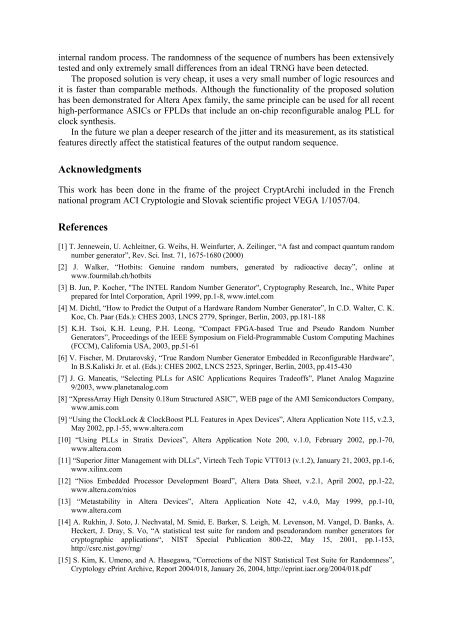SIMPLE PLL-BASED TRUE RANDOM NUMBER ... - KEMT FEI TUKE
SIMPLE PLL-BASED TRUE RANDOM NUMBER ... - KEMT FEI TUKE
SIMPLE PLL-BASED TRUE RANDOM NUMBER ... - KEMT FEI TUKE
You also want an ePaper? Increase the reach of your titles
YUMPU automatically turns print PDFs into web optimized ePapers that Google loves.
internal random process. The randomness of the sequence of numbers has been extensively<br />
tested and only extremely small differences from an ideal TRNG have been detected.<br />
The proposed solution is very cheap, it uses a very small number of logic resources and<br />
it is faster than comparable methods. Although the functionality of the proposed solution<br />
has been demonstrated for Altera Apex family, the same principle can be used for all recent<br />
high-performance ASICs or FPLDs that include an on-chip reconfigurable analog <strong>PLL</strong> for<br />
clock synthesis.<br />
In the future we plan a deeper research of the jitter and its measurement, as its statistical<br />
features directly affect the statistical features of the output random sequence.<br />
Acknowledgments<br />
This work has been done in the frame of the project CryptArchi included in the French<br />
national program ACI Cryptologie and Slovak scientific project VEGA 1/1057/04.<br />
References<br />
[1] T. Jennewein, U. Achleitner, G. Weihs, H. Weinfurter, A. Zeilinger, “A fast and compact quantum random<br />
number generator”, Rev. Sci. Inst. 71, 1675-1680 (2000)<br />
[2] J. Walker, “Hotbits: Genuine random numbers, generated by radioactive decay”, online at<br />
www.fourmilab.ch/hotbits<br />
[3] B. Jun, P. Kocher, "The INTEL Random Number Generator", Cryptography Research, Inc., White Paper<br />
prepared for Intel Corporation, April 1999, pp.1-8, www.intel.com<br />
[4] M. Dichtl, “How to Predict the Output of a Hardware Random Number Generator”, In C.D. Walter, C. K.<br />
Koc, Ch. Paar (Eds.): CHES 2003, LNCS 2779, Springer, Berlin, 2003, pp.181-188<br />
[5] K.H. Tsoi, K.H. Leung, P.H. Leong, “Compact FPGA-based True and Pseudo Random Number<br />
Generators”, Proceedings of the IEEE Symposium on Field-Programmable Custom Computing Machines<br />
(FCCM), California USA, 2003, pp.51-61<br />
[6] V. Fischer, M. Drutarovský, “True Random Number Generator Embedded in Reconfigurable Hardware”,<br />
In B.S.Kaliski Jr. et al. (Eds.): CHES 2002, LNCS 2523, Springer, Berlin, 2003, pp.415-430<br />
[7] J. G. Maneatis, “Selecting <strong>PLL</strong>s for ASIC Applications Requires Tradeoffs”, Planet Analog Magazine<br />
9/2003, www.planetanalog.com<br />
[8] “XpressArray High Density 0.18um Structured ASIC”, WEB page of the AMI Semiconductors Company,<br />
www.amis.com<br />
[9] “Using the ClockLock & ClockBoost <strong>PLL</strong> Features in Apex Devices”, Altera Application Note 115, v.2.3,<br />
May 2002, pp.1-55, www.altera.com<br />
[10] “Using <strong>PLL</strong>s in Stratix Devices”, Altera Application Note 200, v.1.0, February 2002, pp.1-70,<br />
www.altera.com<br />
[11] “Superior Jitter Management with DLLs”, Virtech Tech Topic VTT013 (v.1.2), January 21, 2003, pp.1-6,<br />
www.xilinx.com<br />
[12] “Nios Embedded Processor Development Board”, Altera Data Sheet, v.2.1, April 2002, pp.1-22,<br />
www.altera.com/nios<br />
[13] “Metastability in Altera Devices”, Altera Application Note 42, v.4.0, May 1999, pp.1-10,<br />
www.altera.com<br />
[14] A. Rukhin, J. Soto, J. Nechvatal, M. Smid, E. Barker, S. Leigh, M. Levenson, M. Vangel, D. Banks, A.<br />
Heckert, J. Dray, S. Vo, “A statistical test suite for random and pseudorandom number generators for<br />
cryptographic applications“, NIST Special Publication 800-22, May 15, 2001, pp.1-153,<br />
http://csrc.nist.gov/rng/<br />
[15] S. Kim, K. Umeno, and A. Hasegawa, “Corrections of the NIST Statistical Test Suite for Randomness”,<br />
Cryptology ePrint Archive, Report 2004/018, January 26, 2004, http://eprint.iacr.org/2004/018.pdf








